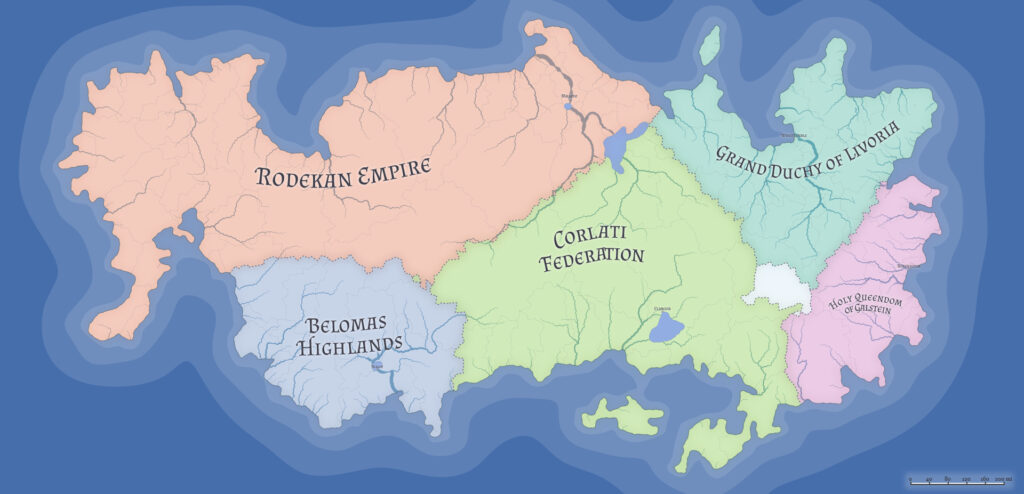Alezon, the Southern Continent

Map of the continent of Alezon, located in the far south of Nixtral. This map features the five major nations of Alezon and was originally made for the Faumen War Chronicles trilogy and other stories to come. This map was made by me through Azgarr’s Fantasy Map Generator.
The Grand Duchy of Livoria
The youngest of the five Alezonian nations, Livoria was founded in AR 741, following the end of the Desolation Wars. Before its founding, what is now Livoria consisted of seven Galstein provinces. Knowing their distance from the Queendom’s capital in Rosenholm, a rising warlord conquered the provinces in AR 731 and brought them under his iron-fisted rule until his eventual death ten years later against the eight Wind Saints, a party of heroes led by the warrior monk, Galen.
After being separate from Galstein for so long, the provinces opted to form a new nation instead, with it’s new capital Whistlevale built on the mouth of the region’s largest river. Rather than risk offending the Queen of Galstein by forming a traditional monarchy of their own, the fledgling nation elected to become a Grand Duchy. The Wind Saints themselves selected fifteen-year-old Tebalect Ardei as Grand Duke, offering guidance to the new ruler for years as it asserted itself as a proper realm. As of AR 1026, at the start of the Faumen War, the current ruling monarch of Livoria is the Grand Duchess Fusette Ardei.
With its multitude of rivers and wide coastline, Livoria is famous for its fishing industry. The northern grasslands also consist of vast stretches of fertile farmland, making it the second largest producer of grains behind the Rodekan Empire. Frequent flooding strikes the central swamps where the country’s Norzen reside, allowing the growth of massive quantities of rice and various herbs not found anywhere else in Alezon.
Since its founding, the duchy has made it a point to provide numerous rights and opportunities to the faumen tribes not normally found elsewhere. Because of this, Livoria has the highest percentage of faumen living within its borders of any Alezonian nation. In terms of weather, Livoria benefits from its position on Alezon’s northeastern corner. The warm ocean currents bring mild, balmy weather and significant rain throughout the year, though the southernmost regions near the Voidlands do suffer from the occasional chilly winter.
Befitting its origins as a nation formed through the actions of the heroes, Livoria was responsible for the formation of the Order of the Windbringers, a church revering the Wind Saints as sacred figures that has taken its place as the official church of both Livoria and Galstein. While not truly considered gods, the Saints are praised and invoked as the historical protectors of Livoria and as heroes within Galstein.
The Holy Queendom of Galstein
Founded in AR 153, the Holy Queendom of Galstein started as a group of communities that came together to protect each other from the encroaching Rodekan Empire. Among this group was a band of faumen descended from those that fled the Belomas Highlands following the Great Rebirth. After driving back the Rodekans, many faumen migrated into the new realm in hopes of seeking out a better life away from the harsh highlands. Seeing the Empire’s brutal treatment of its slaves, Galstein opted to put its fate in the hands of a Queen rather than an Emperor. Senta Graffeld, elder of the region’s largest commune, was chosen by the people to lead as their first Queen. The current ruler of Galstein, as of AR 1026, is Queen Isolde Graffeld.
While many of Galstein’s people worshipped Nixtral’s elemental sprites known as the Origins, another faith took care to amass influence within the fledgling queendom. The Church of Rizalfa, a monotheistic faith from Rodekan that worshipped the harvest god it derived its name from, used their rudimentary knowledge of science to develop a following within Galstein. The church enjoyed a prosperity not found in its native lands until a mysterious epidemic wiped them out, leaving a swath of mountainous land near the current border with Livoria uninhabited due to a fear of the epidemic resurfacing.
Despite being smaller than its neighbors, Galstein is a prosperous nation with a thriving forestry industry. Its soil is considered the most fertile in all of Nixtral, allowing many plants to grow exponentially faster compared to other regions. This also makes Galstein important for the quality and amount of medicinal herbs it produces. Few nations in Nixtral can match the potency of Galstan herbal remedies.
Galstein’s climate tends to be a cooler and drier than its northern neighbors, though the northernmost third of the country can see hot summers. The southern third of Galstein is littered with flat prairies, while the west is more hilly and mountainous. Forests cover much of the remaining land area.
The Corlati Federation
Originally a group of Rodekan provinces, the Corlati Federation was founded in AR 490 when the provinces, tired of the Empire’s oppressive rule and excessive taxation, rose up in bloody revolution. Despite declaring independence in 490, Corlati didn’t receive official recognition until it drove Rodekan to seek a peace treaty three years later. Afterwards, the provinces banded together to form a federation in which a Senate of wealthy and powerful members of Corlatian society develop laws for the federation at large, while each province retains relative autonomy in most internal affairs. The Senate elects a sitting member to serve as President for a single seven year term, guiding and enforcing such policies as official alliances, trade treaties, and declarations of war. As of AR 1026, the current President of Corlati is Gideon Harmod, a wealthy merchant specializing in the exotic animal trade.
Unlike the other Alezonian nations, the Corlati Federation is explicitly anti-faumen, with human superiority preached as gospel by those in power. In addition, Corlati has a thriving slave trade, kidnapping and purchasing faumen and even other humans from other nations and beating them into submission within slave houses, making them pliable for their buyers.
Corlati is famous for its industrial might. After acquiring the blueprints for a steam engine invented by a Livorian craftsman in AR 932, Corlati made use of the technology to enhance their metalsmithing capabilities. While other nations are still easing the use of steam technology into their everyday lives, Corlati has fully integrated it, allowing them to produce certain goods at a high speed, though of lower quality than what you would find elsewhere. The Federation is also a massive exporter of certain grains such as corn and barley.
As the central nation of Alezon, Corlati sees a wide variety of climates and types of land. This ranges from the mountains that form its northeastern border with Livoria, to the central plains and southern taigas.
The majority of Corlatians follow Cadism, a faith dedicated to the war-like teachings of the warrior monk Cadell. A former priest, Cadell was driven to grief when his family was killed by a group of faumen fleeing the Empire during the Federation’s war for independence. In revenge, he took up the sword against all faumen and became an infamous warrior and one of Corlati’s greatest military leaders. While many follow the monk’s teachings, few go on to become fully indoctrinated monks themselves, as it requires a lifetime’s dedication to learning the arts of war and intense physical training.
The Rodekan Empire
The oldest and largest of Alezon’s nations, Rodekan’s early history was marked by years of war and bloodshed. Originally founded in 568 BF, the Empire was formed when the Rodekan tribe of Lake Danpa subjugated all of its neighboring clans. Using their new subjects as an army, the Rodekans expanded their influence throughout northern Alezon until they conquered the majority of the continent, including parts of the northern continent Feswili. The nation follows a patriarchal line of succession, with the oldest male of the royal clan reigning as Emperor. The sitting Emperor of Rodekan as of AR 1026 is Kabuji Aduleji.
Through the use of early slave labor, Rodekan developed a stable farming industry before delving into the uncharted regions of the Belomas Highlands in 10 BF. It was there they encountered and enslaved several tribes with an innate connection to Nixtral’s natural energies. Desperate to harness this power for themselves, the Rodekans performed vile experiments on the native tribes over the next ten years, resulting in the Great Rebirth that created the faumen. The immediate aftermath was devastating, as the bestial faumen successfully rebelled against their oppressors and scattered to the far corners of Nixtral.
Over the next 150 years, Rodekan decreased its reliance on the slave trade while attempting to expand eastward. They found themselves stymied when the inhabitants of the east banded together to form an alliance that would eventually grow into the Holy Queendom of Galstein. Still reeling from their experience with the faumen, the Empire fell back and retained control of their territories until the eastern provinces revolted and obtained their independence, forming the Corlati Federation in AR 490.
Since then, Rodekan has maintained a quiet, if tense, peace with its neighbors, with only a few northern colonies remaining of its once vast empire. It remains the largest producer of grains and textiles on the continent, and enjoys warm, temperate weather through most of the year, though summers in the northern savannahs can be unbearably hot and humid.
The Belomas Highlands
While considered a full nation of Alezon, Belomas is an oddity in that it has very little in the way of centralized rule. Instead, it is mostly comprised of nomadic tribes and scattered city-states that meet on a regular basis in the nation’s ‘capital’ of Birov to address concerns that affect the Highlands as a whole. In order to appease each group, major decisions are made by the Chiefs’ Council, consisting of the leaders of every tribe and city-state. Leadership of the Council rotates to a new chief every three years. As of AR 1026, the current leader of the Council is Chief Velibor of the Aerivolk city-state, Toska.
Despite their laid-back manner, the Belomian people are fiercely protective of their home and known for being unmerciful with anyone foolish enough to attack them. Even the Corlati Federation, feared throughout Nixtral for their military might, is hesitant to attempt an invasion of Belomas, knowing the slightest slip-up would be catastrophic.
Most famous as the original home of the faumen tribes, Belomas is a mineral-rich region that thrives on it’s mining industry. Many of the rarest gems and stones used in crafting come from the Highlands, including the gold each nation uses for their coinage. A wide variety of hardy medicinal herbs and root vegetables flourish here, making their export surprisingly profitable. The weather ranges wildly from the temperate steppes of the north to the colder mountains and taigas near the southern coast.
